Abstract
Transposon Tn7 codes for resistance to trimethoprim and streptomycin. For detection of Tn7 by DNA-DNA hybridization, two recombinant plasmids were constructed. The former contained a 1-kilobase BamHI fragment and the latter contained a 4.3-kilobase EcoRI-BamHI fragment of Tn7. These DNA fragments, which did not include the drug resistance genes, were used as probes for detecting Tn7-like sequences in bacterial strains by colony hybridization. They hybridized strongly to bacterial DNA known to carry Tn7 but not to DNA known to carry transposons other than Tn7. These probes were used to study the occurrence of Tn7 in bacterial strains isolated in the Turku City Hospital in Finland. Transposon Tn7 was present in 47.2% of 199 trimethoprim-resistant enterobacteria (MIC greater than or equal to 8 micrograms/ml). Among the 69 Proteus mirabilis strains studied, 75% contained Tn7, although none of these strains transferred trimethoprim resistance in conjugation tests. The reliability of colony hybridization was further confirmed by Southern hybridization to detect the Tn7-specific 2.6-kilobase HindIII restriction fragment. Colony hybridization proved to be a sensitive and rapid method for detecting Tn7-determined sequences.
Full text
PDF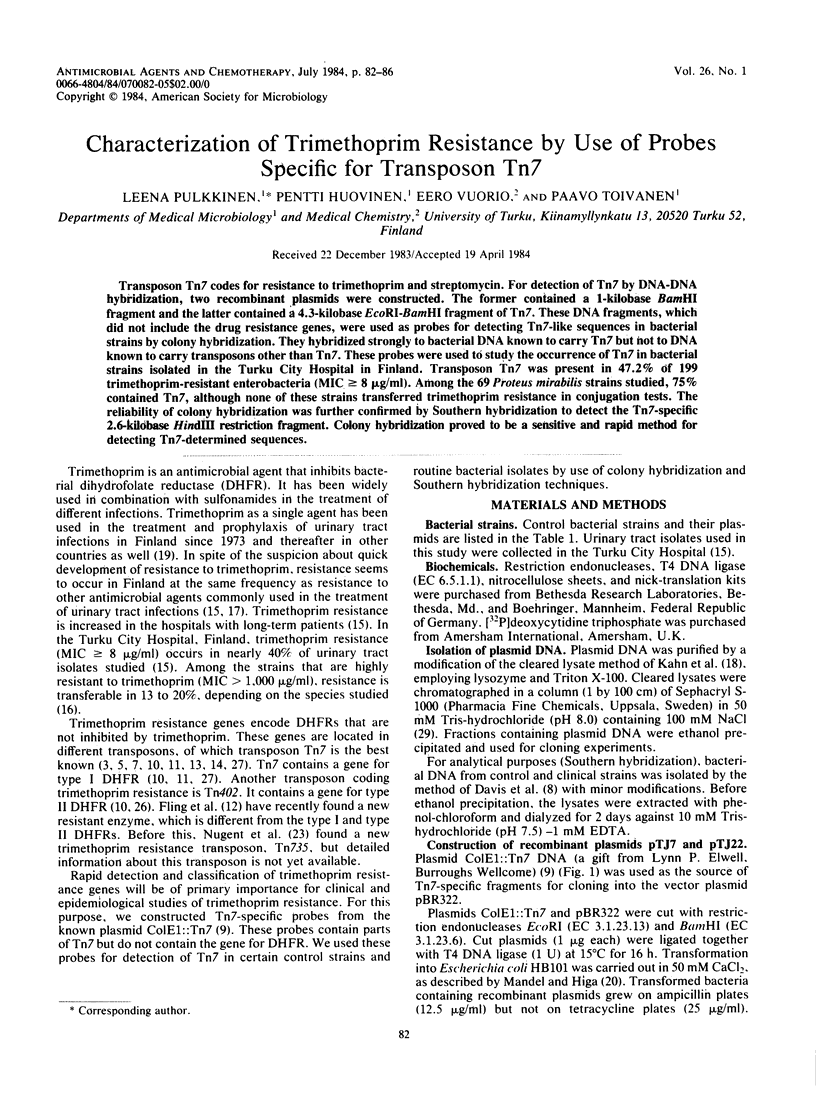
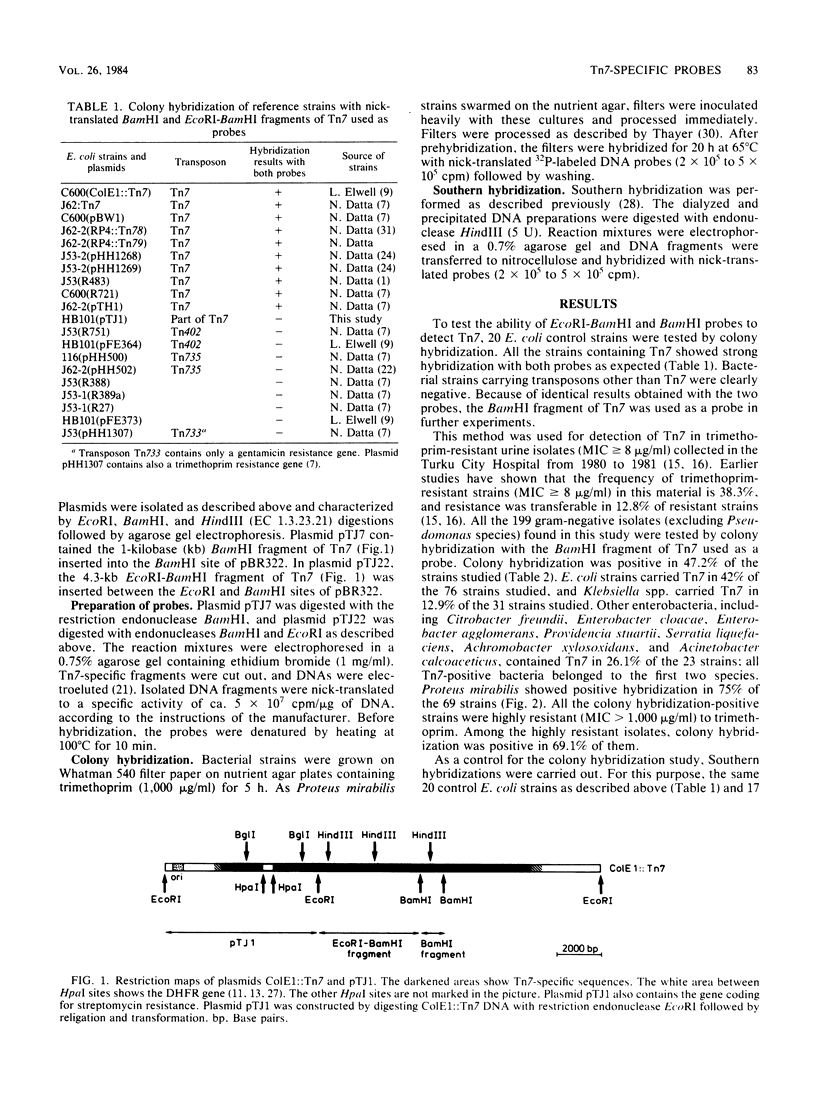
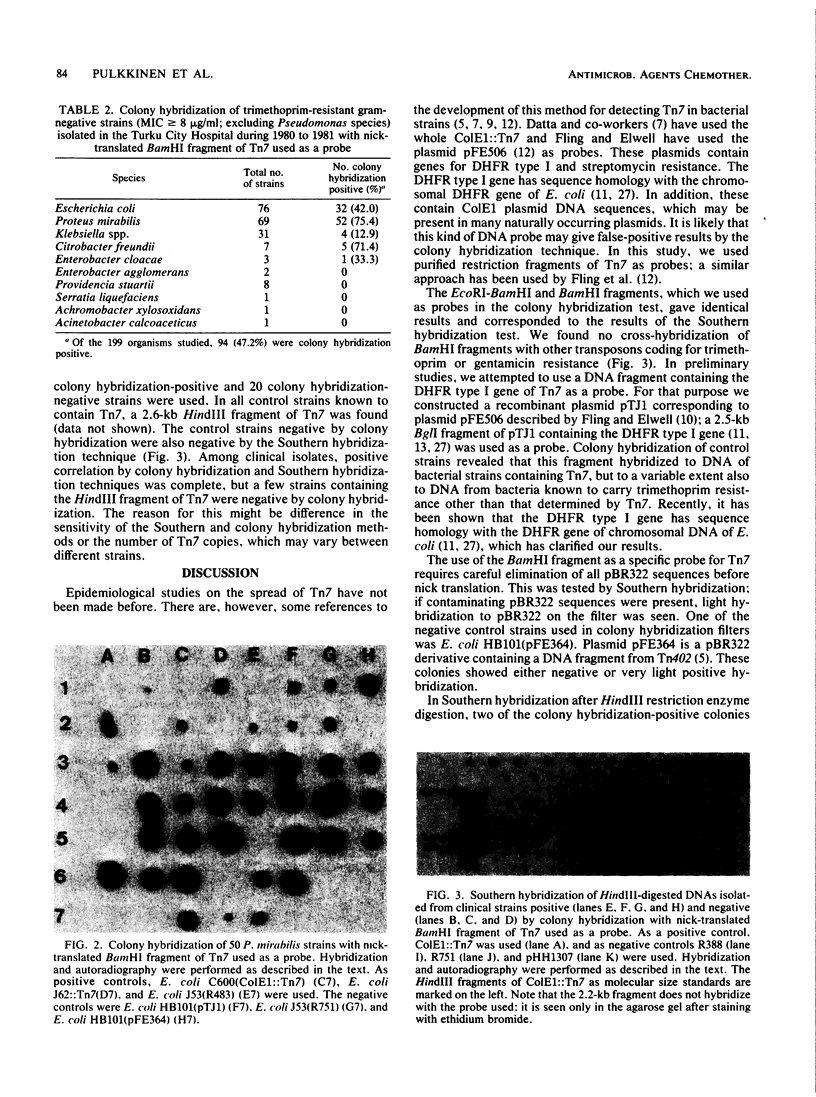
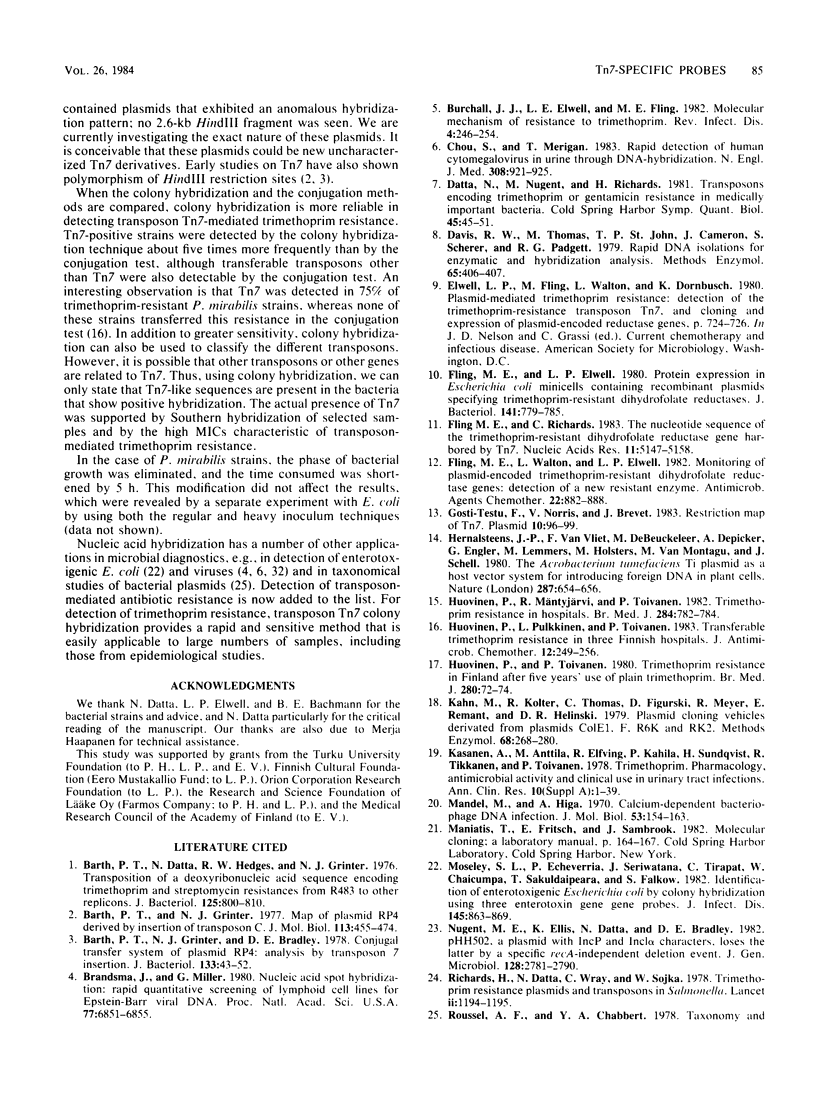
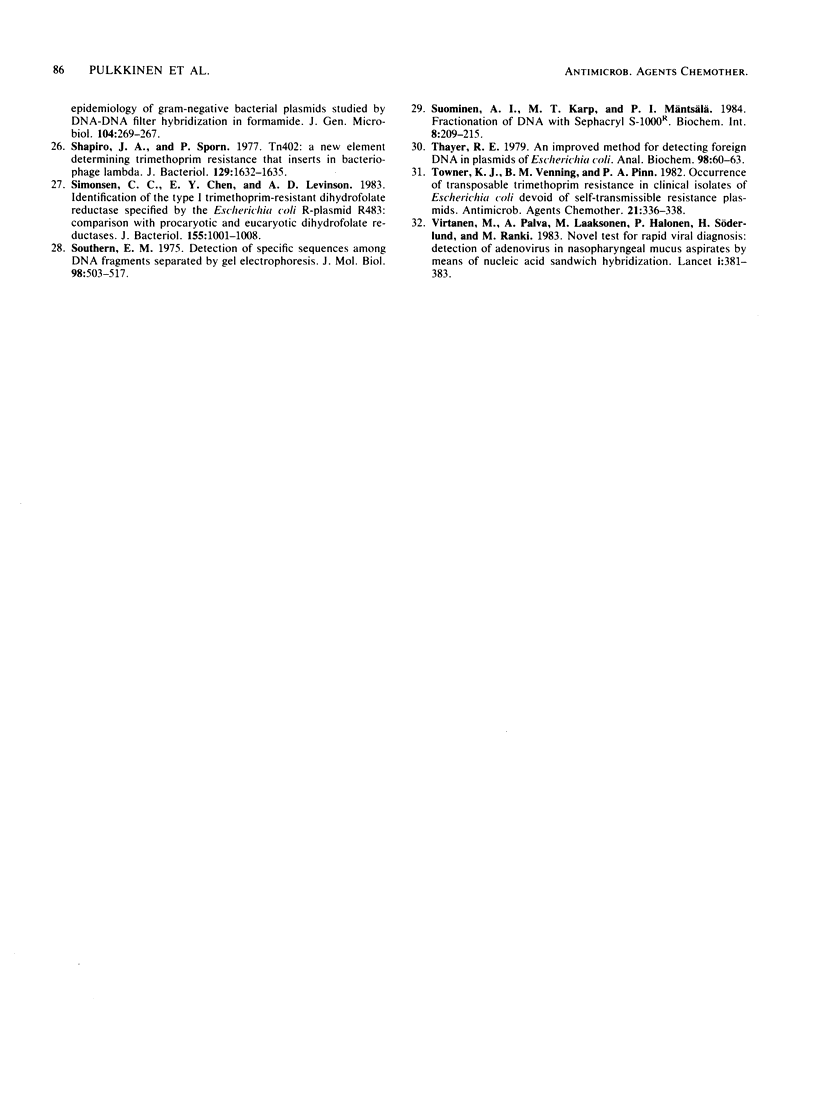
Images in this article
Selected References
These references are in PubMed. This may not be the complete list of references from this article.
- Barth P. T., Datta N., Hedges R. W., Grinter N. J. Transposition of a deoxyribonucleic acid sequence encoding trimethoprim and streptomycin resistances from R483 to other replicons. J Bacteriol. 1976 Mar;125(3):800–810. doi: 10.1128/jb.125.3.800-810.1976. [DOI] [PMC free article] [PubMed] [Google Scholar]
- Barth P. T., Grinter N. J., Bradley D. E. Conjugal transfer system of plasmid RP4: analysis by transposon 7 insertion. J Bacteriol. 1978 Jan;133(1):43–52. doi: 10.1128/jb.133.1.43-52.1978. [DOI] [PMC free article] [PubMed] [Google Scholar]
- Barth P. T., Grinter N. J. Map of plasmid RP4 derived by insertion of transposon C. J Mol Biol. 1977 Jul 5;113(3):455–474. doi: 10.1016/0022-2836(77)90233-9. [DOI] [PubMed] [Google Scholar]
- Brandsma J., Miller G. Nucleic acid spot hybridization: rapid quantitative screening of lymphoid cell lines for Epstein-Barr viral DNA. Proc Natl Acad Sci U S A. 1980 Nov;77(11):6851–6855. doi: 10.1073/pnas.77.11.6851. [DOI] [PMC free article] [PubMed] [Google Scholar]
- Burchall J. J., Elwell L. P., Fling M. E. Molecular mechanisms of resistance to trimethoprim. Rev Infect Dis. 1982 Mar-Apr;4(2):246–254. doi: 10.1093/clinids/4.2.246. [DOI] [PubMed] [Google Scholar]
- Chou S., Merigan T. C. Rapid detection and quantitation of human cytomegalovirus in urine through DNA hybridization. N Engl J Med. 1983 Apr 21;308(16):921–925. doi: 10.1056/NEJM198304213081603. [DOI] [PubMed] [Google Scholar]
- Datta N., Nugent M., Richards H. Transposons encoding trimethoprim or gentamicin resistance in medically important bacteria. Cold Spring Harb Symp Quant Biol. 1981;45(Pt 1):45–51. doi: 10.1101/sqb.1981.045.01.009. [DOI] [PubMed] [Google Scholar]
- Fling M. E., Elwell L. P. Protein expression in Escherichia coli minicells containing recombinant plasmids specifying trimethoprim-resistant dihydrofolate reductases. J Bacteriol. 1980 Feb;141(2):779–785. doi: 10.1128/jb.141.2.779-785.1980. [DOI] [PMC free article] [PubMed] [Google Scholar]
- Fling M. E., Richards C. The nucleotide sequence of the trimethoprim-resistant dihydrofolate reductase gene harbored by Tn7. Nucleic Acids Res. 1983 Aug 11;11(15):5147–5158. doi: 10.1093/nar/11.15.5147. [DOI] [PMC free article] [PubMed] [Google Scholar]
- Fling M. E., Walton L., Elwell L. P. Monitoring of plasmid-encoded, trimethoprim-resistant dihydrofolate reductase genes: detection of a new resistant enzyme. Antimicrob Agents Chemother. 1982 Nov;22(5):882–888. doi: 10.1128/aac.22.5.882. [DOI] [PMC free article] [PubMed] [Google Scholar]
- Gosti-Testu F., Norris V., Brevet J. Restriction map of Tn7. Plasmid. 1983 Jul;10(1):96–99. doi: 10.1016/0147-619x(83)90061-6. [DOI] [PubMed] [Google Scholar]
- Huovinen P., Mäntyjärvi R., Toivanen P. Trimethoprim resistance in hospitals. Br Med J (Clin Res Ed) 1982 Mar 13;284(6318):782–784. doi: 10.1136/bmj.284.6318.782. [DOI] [PMC free article] [PubMed] [Google Scholar]
- Huovinen P., Pulkkinen L., Toivanen P. Transferable trimethoprim resistance in three Finnish hospitals. J Antimicrob Chemother. 1983 Sep;12(3):249–256. doi: 10.1093/jac/12.3.249. [DOI] [PubMed] [Google Scholar]
- Huovinen P., Toivanen P. Trimethoprim resistance in Finland after five years' use of plain trimethoprim. Br Med J. 1980 Jan 12;280(6207):72–74. doi: 10.1136/bmj.280.6207.72. [DOI] [PMC free article] [PubMed] [Google Scholar]
- Kahn M., Kolter R., Thomas C., Figurski D., Meyer R., Remaut E., Helinski D. R. Plasmid cloning vehicles derived from plasmids ColE1, F, R6K, and RK2. Methods Enzymol. 1979;68:268–280. doi: 10.1016/0076-6879(79)68019-9. [DOI] [PubMed] [Google Scholar]
- Kasanen A., Anttila M., Elfving R., Kahela P., Saarimaa H., Sundquist H., Tikkanen R., Toivanen P. Trimethoprim. Pharmacology, antimicrobial activity and clinical use in urinary tract infections. Ann Clin Res. 1978;10 (Suppl 22):1–39. [PubMed] [Google Scholar]
- Moseley S. L., Echeverria P., Seriwatana J., Tirapat C., Chaicumpa W., Sakuldaipeara T., Falkow S. Identification of enterotoxigenic Escherichia coli by colony hybridization using three enterotoxin gene probes. J Infect Dis. 1982 Jun;145(6):863–869. doi: 10.1093/infdis/145.6.863. [DOI] [PubMed] [Google Scholar]
- Nugent M. E., Ellis K., Datta N., Bradley D. E. pHH502, a plasmid with IncP and IncI alpha characters, loses the latter by a specific recA-independent deletion event. J Gen Microbiol. 1982 Nov;128(11):2781–2790. doi: 10.1099/00221287-128-11-2781. [DOI] [PubMed] [Google Scholar]
- Richards H., Datta N., Sojka W. J., Wray C. Trimethoprim-resistance plasmids and transposons in Salmonella. Lancet. 1978 Dec 2;2(8101):1194–1195. doi: 10.1016/s0140-6736(78)92171-2. [DOI] [PubMed] [Google Scholar]
- Shapiro J. A., Sporn P. Tn402: a new transposable element determining trimethoprim resistance that inserts in bacteriophage lambda. J Bacteriol. 1977 Mar;129(3):1632–1635. doi: 10.1128/jb.129.3.1632-1635.1977. [DOI] [PMC free article] [PubMed] [Google Scholar]
- Simonsen C. C., Chen E. Y., Levinson A. D. Identification of the type I trimethoprim-resistant dihydrofolate reductase specified by the Escherichia coli R-plasmid R483: comparison with procaryotic and eucaryotic dihydrofolate reductases. J Bacteriol. 1983 Sep;155(3):1001–1008. doi: 10.1128/jb.155.3.1001-1008.1983. [DOI] [PMC free article] [PubMed] [Google Scholar]
- Southern E. M. Detection of specific sequences among DNA fragments separated by gel electrophoresis. J Mol Biol. 1975 Nov 5;98(3):503–517. doi: 10.1016/s0022-2836(75)80083-0. [DOI] [PubMed] [Google Scholar]
- Suominen A. I., Karp M. T., Mäntsälä Fractionation of DNA with Sephacryl S-1000. Biochem Int. 1984 Feb;8(2):209–215. [PubMed] [Google Scholar]
- Thayer R. E. An improved method for detecting foreign DNA in plasmids of Escherichia coli. Anal Biochem. 1979 Sep 15;98(1):60–63. doi: 10.1016/0003-2697(79)90705-x. [DOI] [PubMed] [Google Scholar]
- Towner K. J., Venning B. M., Pinn P. A. Occurrence of transposable trimethoprim resistance in clinical isolates of Escherichia coli devoid of self-transmissible resistance plasmids. Antimicrob Agents Chemother. 1982 Feb;21(2):336–338. doi: 10.1128/aac.21.2.336. [DOI] [PMC free article] [PubMed] [Google Scholar]
- Virtanen M., Palva A., Laaksonen M., Halonen P., Söderlund H., Ranki M. Novel test for rapid viral diagnosis: detection of adenovirus in nasopharyngeal mucus aspirates by means of nucleic-acid sandwich hybridisation. Lancet. 1983 Feb 19;1(8321):381–383. doi: 10.1016/s0140-6736(83)91500-3. [DOI] [PubMed] [Google Scholar]




